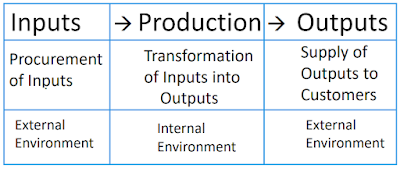Introduction to Business Environment
There are 3 Institutions for allocation of resources
- Market (Private Sector):
- The decentralized market or capitalist system
- It operates on the basis of
- Private property
- Voluntary exchange
- Competition, and the profit motive.
- Government (Public Sector):
- Centralized Mechanism
- In this government can use its tax-raising powers to provide public services to citizens on the basis of criteria other than ability to pay.
- Community (Voluntary/third/popular):
- Decentralized mechanism for allocating resources
- Its purpose is to meet certain categories of need rather than to make a profit.
Business Environment:
There are 2 types of business environment:
- Internal:
- Production (transformation of inputs to outputs)
- External:
- Procurement of Inputs
- Supply of outcomes to customers
Environment of Business
- Market Environment:
- Includes those interactions between firms, suppliers, and customers that involve:
- Voluntary economic transactions
- The exchange of property.
- Non-Market Environment:
- Composed of the social, political, and legal arrangements
- It structure interactions between the
- Firm and individuals
- Interest groups
- Government entities
- Public that are intermediated not by markets but by public and private institutions.
Here, Companies business markets are
- Companies market environment
- Competitors
- Consumers
- Suppliers
- Companies Non market environment
- Regulators
- Government's
- Citizens
- NGO's
- Activists
- Media
- Market Environment
- Money
- Leadearship
- Flexibility
- Predictability
- Value
- Non Market Environment
- Information
- Coalitions
- Consistency
- Uncertanity
- Values
- Management of Market Environment:
- Efficiency
- Adaptability
- Innovation
- Responsiveness to Consumer Demand
- Management of Non-Market Environment:
- Managing government regulations
- Public pressure
- Media coverage
- International treaties and human rights
- Global challenges like climate change
- Ethics
- Corporate social responsibility
- Legal compliance
Drivers of Non-Market strategy
- Multiple Audiences
- Globalization of NGOs
- New regulatory Hurdles
- Competitive Edge
Analysis of Business Environment
- PEST
- It is a simple framework for environmental analysis that distinguishes four categories or areas:
- P: Political
- E: Economic
- S: Social
- T: Technological
- SWOT
- It is a framework that combines internal and external analyses
- The strengths and weaknesses of the organization coupled with the opportunities and threats in the external environment.
- S: Strength (Internal)
- W: Weakness (Internal)
- O: Opportunity (External)
- T: Threat (External)


No comments:
Write commentsPlease do not enter spam links